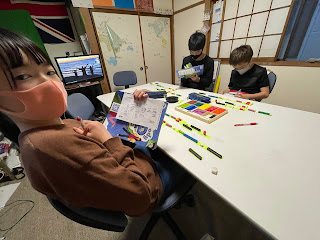 |
| Supplements to class books |
I think graded readers have a place in every language learning environment; they certainly play an important part in our learning goals at Luna, and have proven their worth many times over as our students have blossomed from learning first words to biting off big chunks in Cambridge exams - be it entry level Young Learners (
pre-A1Starters) to
B2:First with us here at
JP004.
Young Learners are rarely independent learners, so we use our readers in class to form good habits; get used to the format & style, find the audio or read along with the teacher narrating - we love correcting the teacher if he/she 'makes a mistake'! We exploit the artwork to predict or reflect, recycle & repeat. We get used to the kinds of tasks that are included in the puzzle pages, and understand that we absolutely can turn the pages back to find what we are looking for together (is it a team race? are we working in pairs? are the books on the table even? which pages do we need to look at?) Follow the directions (which are also in English). Stuck? Ask peers or the teacher for help, of course it's OK!
 |
| Exploit the glossary |
Good choice of reader will mean you can easily suppliment/compliment your regular course books, be it in terms of vocabulary or target structure. Working on animals or numbers...prepositions or suggestions...culture, values, social studies or science?
Use your readers for much more than 'just reading' and instead a launch pad for inquisitive minds & project work in all shapes and forms - a talking picture of a favourite character being interviewed maybe...a poster or illustration personalising vocabulary & self...scaffolded writing eg focussing on personification, localisation or prediction...use the 'hard' or new words imaginatively not as 'test' items.
Make a meal out of the level of language, and the repetitive nature of graded reader titles? Notice, for
 |
| pronunciation mining |
example, when you can take advantage of regular past tense verbs. Make it a listening task & colour code your
-ed endings and then organise them - organise them into sets in side the front cover (invariably blank real estate there!). Can your learners match up the (probably limited number of) irregular past tense verbs with their dictionary form - another reason to re-read (but this time scanning) & quickly.
 |
| Collaborating on a project |
Reading out loud? I really think this is a bad idea for so many reasons (stage fright, fear of mistakes, "I'm too slow", not confident with big words, wasn't in class last week, didn't hear the audio etc)! Instead, narrate the story yourself (model good pronunciation/intonation, speed) and only have your students speak particular roles each. This encourages them to read ahead & identify direct speech and to figure out who is speaking...this can take time but let them do that together & agree! What words in the text help us do that? How does the speaker speak (cry? shout? whisper?)...it has meaning! But don't flog it - save more for next week and only give 'homework' if they can do it/know how to do it. Can they actually access the audio components, for example.
Lastly for now, with digital versions of readers available (OUP did a fantastic job in 2020 offering their reading bookshelf titles available for free) it is not hard to cater for online learners as well as our F2F cohort to stay on the same page. Takes a bit of thinking about, but the room for even more exploitation of the materials is there - US or British narration as well as fast/normal/slow choices. Most importantly, enjoy. Reading will yield the best results over time, at a regular, steady pace, at 'not-too-hard' levels and with meaningful engagement/activities. Keep track of progress - not just word count or number of books read, or obsess over reading speed...but build portfolios for your students, give them the confidence to skip tough words & come back later with an informed guess over meaning if they have to; don't translate everything, and don't stuff it all up by making it a test.

























